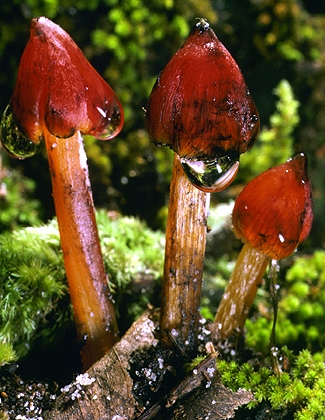
Hygrocybe astatogala (R.Heim) Heinem.

Common name: None.
Description: This species has caps that are 24 (5) cm in diameter. The caps are conical, dry, fibrillose with black fibrils and often torn or splitting at the margins; the colour is very variable: brilliant red, orange, yellow or mixtures of all these colours and sometimes with a greenish tint. The entire cap blackens on bruising and slowly blackens with age. Tasmanian collections are mostly found in the jet-black form. The flesh is yellowish and weeps a clear or yellow-tinted, watery liquid on cutting. The gills are yellow to orange, waxy, thick, distant, ascending and blacken quickly on bruising. Stems may be up to 8 cm long and 0.5 cm thick. They are hollow and split longitudinally, and are dry, pale yellow to orange and often have reddish tints. There is no ring. Usually the stem is more or less covered with black fibrils.
The spores measure 710 × 68.5 µm and are often subglobose, but they can be very broadly ellipsoidal; they are smooth and mostly colourless although some appear brown-tinted. The spores are white in mass.
Substratum: Hygrocybe astatogala is found on soil among litter or moss in forests. It usually occurs in twos or threes but, under ideal conditions, may be found in large troops.
Distribution: Known from all eastern mainland States and Tasmania.
Notes: This very beautiful fungus was first described from Madagascar by the mycologist R.Heim and placed in the genus Bertrandia because of the liquid that exudes when it is cut. The thick waxy gills (as well as other characters) make it a relative of the species in genus Hygrocybe, and, today, most mycologists think that it is better placed in Hygrocybe. Australian collections were first misidentified as Hygrocybe conica, a European species which does occur in Australia although it is uncommon. The latter is easily distinguished as it does not have either the watery exudate or the abundant black fibrils on cap and stem.
